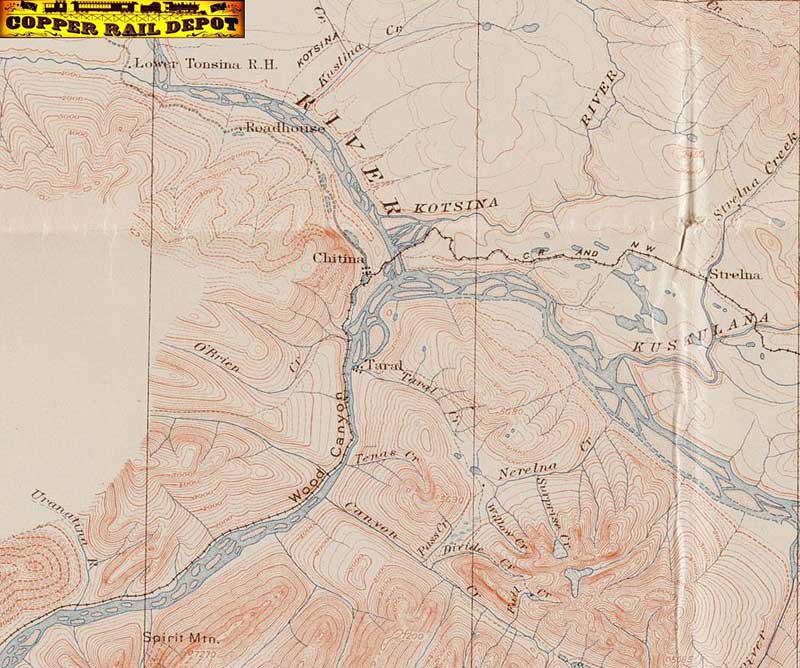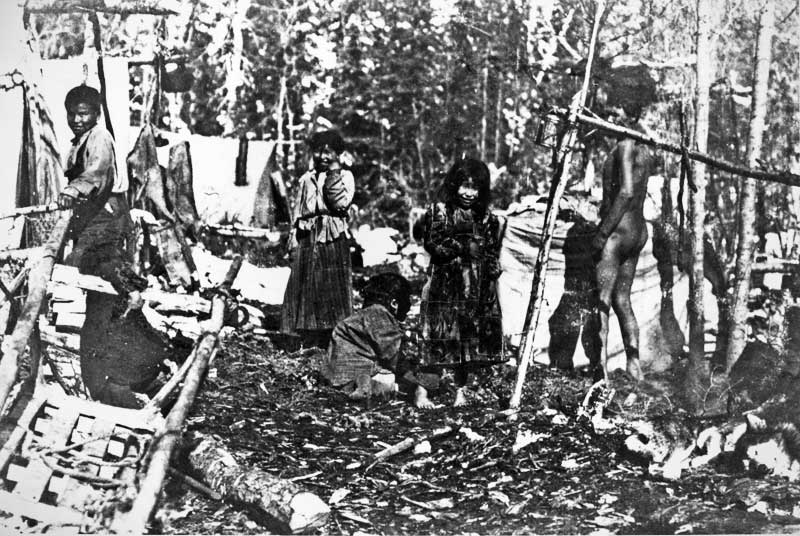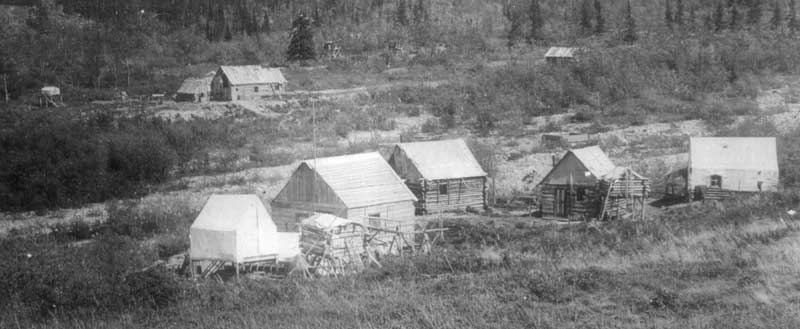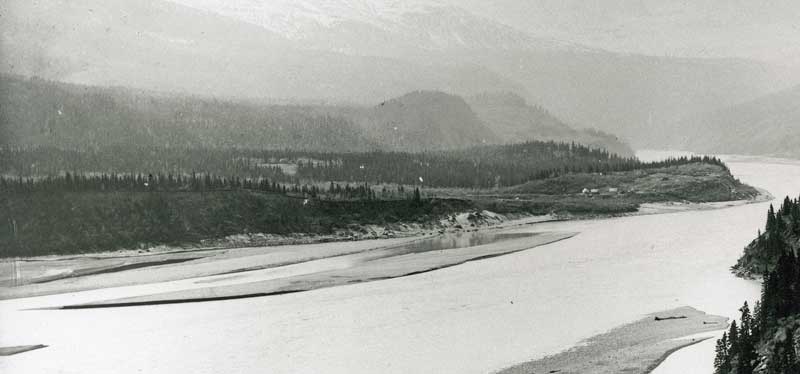Continue with
Chapters from the historic novel "Legacy of the Chief," by Ronald Simpson, and other items mostly related to the historic background of the Ahtnas in the context of Kennecott Copper & its Copper River & Northwestern Railway.
02 November 2010
01 November 2010
Ch 7, Pt 2: "The Deal," from "Legacy of the Chief"
Chapter 7, part 2: "The Deal," from "Legacy of the Chief" |
Ch 7, Pt 1: "The Deal, " from "Legacy of the Chief"
| Chapter Seven, "The Deal," from "Legacy of the Chief" | |
Skolai Nicolai of Taral --the great peacemaker | This is my personal account. We don't know what really happened. All we have are the stories. There is the official history which would make one believe that Nicolai was a fool who traded access to an unimaginable fortune in high-grade copper for a cache of food. The there is our story--the one handed down over the generations that tells us of the truly desperate situation which Nicolai saw and the deal he felt he had to make for his people in order that they could survive. What transpired in the small and very ancient village of Taral--now a deserted and forbidden place occupied only by the spirits--could be considered one of the most notorious trades of all times. For it is true that the prospector party who made the deal ultimately made a great deal of money from the Guggenheims. As for the money they made, well, in today's terms it would be in the billions of dollars. To this day people do not understand that Nicolai did the best he could possibly do for his people, and in his own way he succeeded. All of his demands were ultimately met, although mostly after his death. Nicolai withdrew from everyone after he made this deal. He literally disappeared into the mists of time. The events surrounding his death are mostly a matter of speculation among historians. They are sure he died in 1900. They are wrong. Nicolai lived almost as a hermit in Taral until many years later--choosing to stay completely out of sight because he too feared he had made the wrong choices. He had not. He had done the only thing he could do and he had made a lasting peace in the process --a peace which was unknown among the stateside tribes who mostly were destroyed by the deadly effects of the inevitable encroachment of the European society. Yet Nicolai set the tone for a permanent peace between the interior people and the U.S. military and the people who followed that was honored by all the interior Athabascans. In the end, he probably saved his people far more than he ever realized. |
 | |
So it finally came down to this. The three white men who called themselves the McClellan Company, headed by a fellow named Edward Gates, and also including James McCarthy and Art McNeer, appeared at the camp of Chief Nicolai, Tyone of Taral, with their intentions clearly stated. Fourteen years before, Lieutenant Henry Allen found Nicolai in his winter camp on Dan Creek. Nicolai called this land the Tsedi Na. The white men changed that to Chittyna before finally settling on Chitina--Copper River. It was the tsedi. They wanted the copper. But not just any copper. An abundance of copper nuggets--some of them quite substantial--could be found in the creek bottoms of the glacial steams in the area. This type of nugget was called float by the white men. It is just a showing. Had the metal been gold--a mineral of considerable value--they might have contented themselves with what they could find in the streams. After all, Stephen Birch and his brother Howard did well in the gold-placer business on Dan Creek. But this was copper. The highest copper value was about twenty cents a pound at a time when gold was about twenty dollars an ounce. Typical white men. They wanted more. Copper was only potentially valuable in our remote area as a high-grade metal in massive quantities. Was there a mother lode in the Wrangell Range? They wanted the source. They knew there had to be one. Where was it? What would it take to convince one of you to lead us to the source? The lieutenant had once asked. “I see copper everywhere. I see it in the streams. It’s in your bullet casings and your arrows and spears. Is there anything like this in the hills?” The lieutenant held up a piece of rock sitting along the wall inside the tyone’s lodge. It was obviously chipped out of a larger piece. It contained hues of bright green and blue. It was not rounded like those which could be found in the creek beds. We used these pieces for arrowheads. The chief turned toward the hills across the Nizina River. He pointed in the direction of his favorite hunting area toward the north across the Chitistone River. Nicolai’s brother Skilly told us grandchildren this story. Skilly led the U.S. Army party to Nicolai’s camp. He told us that all of the white men turned silent upon watching Nicolai make that simple pointing motion and say those few words. It was as if they had found the location of something holy. When he finally asked Nicolai to describe the place, Nicolai waved him off and told him that it was time to feast. Nicolai sensed that he had just done something he might later regret. He did not discuss the location with a white man again until 1899. The lieutenant only wanted to know that such a source existed. He was not a prospector. He was just the head of a small expedition that came to assess the attitude of the Natives toward the government, map the region, and do some preliminary geological investigations. That was the end of that. Or so the chief hoped. This early meeting, however, was only the beginning of a series of government expeditions. Then came the small independent prospecting activities fueled by considerable speculation as to the value and location of the copper lodes in the Wrangells.
Over the next fourteen years, the legend of a rich vein of copper which was now reinforced by this early encounter between Nicolai and Allen, would grow. Then came the white incursion of 1898-99 by way of the Valdez-Klutina Glaciers. Now they were once again at Nicolai’s door at what would soon be the last true remaining Native village in our lower river area from the old days, Taghaelden--otherwise known as Taral. Nicolai was still the supreme chief. After that last embarrassing incident at Tonsina, the people of Nicolai sheepishly began to filter back in, just as Goodlataw had said they would. Fishing and hunting activities resumed with a greater enthusiasm than ever. But it was late in the year. There was so little time and the game remained scarce. The fish stopped running. Starvation appeared to be inevitable unless the game which had been absent all summer suddenly appeared in the frigid depths of the winter. The timing could not have been better for Edward Gates and the other prospectors. Nicolai headed a group of deathly-appearing people who were beginning to resemble some of those early prospectors who came into Taral half-starved.
A white man with a cache of food was in a strong bargaining position. Ed Gates and his party laid out their proposal simply enough. They had a full season’s cache of food for their party which they had stashed earlier along the Bremner River. They would consider splitting it up with Nicolai’s people in return for access to the lode which was known only by a handful of Ahtna Natives. The first indications of the impending starvation had already set in. The white man diseases were beginning to take their toll as well. The game was scarce and the supply of salmon was nearly gone. The white men had entered the area in force. With them had come an unending supply of alcohol. Even if winter game moved in, little doubt remained as to who would get most of it. The future of the Ahtnas was in doubt. Too much had changed too quickly. Most of those who had crossed the river to live on the west bank, with the relatively easy access to white men’s goods and especially whiskey, had changed their outlook. The Ahtnas listened to their tyone only when it suited them. His word no longer carried the weight it once had. For many, the old ways of life had become nothing more than a memory. The future had been laid out for all to see. It was a white man’s society. Life was about grow easier. The time was coming when it would no longer necessary that everyone hunt, trap, and fish as before. The new society had brought in the goods that made life a measure easier as long as money could be obtained. Trapping for valuable pelts and guiding for rich trophy-hunters became more important than hunting and traditional trapping and fishing. Guiding in those early days was particularly lucrative. Many Indians would be able to benefit from their intimate knowledge of the Wrangells and the Copper River valley. In Nicolai’s old society, a strict class structure existed. At the very top was the tyone , then came his chiefs, their warriors and their lead hunters. In a class of their own were the solitary sleep-doctors. They were in a world of their own, and would quietly survive the white system which would destroy the tyone. At the bottom were the young men, followed by the women and children. At least they were valued and protected. They had no voice in the activities of the clan. Several clans existed in the valley. Nicolai’s Raven clan was dominant when Lieutenant Allen first ascended the Copper River. Each clan had its own village or camp and was headed by its own chief. Room existed for only one tyone. He, above all else, represented the past. The old class system crumbled rapidly with the coming of the white man. The women began to see many of their own men as mainly drunk and largely useless. They began assuming more of the traditional male roles in order to preserve their families. In the early days only a few of the women participated in the drinking, but almost all of the men did. In a few generations the women began taking control of the villages. The villages became more important than the clans. The old clan ways began to disappear along with the elders and their system headed by the tyone. Despite the worst fears of the tyone, there is something in the nature of being an Indian which just would not go away. The old system was doomed, but the Indians would always be Indians. One day, the pride which was so badly damaged in these early days of the intrusion of the white man, would begin to seep back in. One day, the spirit which was Nicolai would begin to return. In the winter of 1899 the breakdown of the clan system was apparent everywhere. Much to the embarrassment of the chief, it was equally obvious to the white prospectors. On that particularly fateful day in midwinter, the prospectors simply showed up. They had worked their way up the river ice from the Bremner area to the south.
Nicolai’s lode. The tyone had never thought of it that way. This was what those prospectors wanted. They even named the legendary copper after him. The chief had never been all that impressed with what the white men had to offer, though he loved the rifles, the blankets and the rice. He had also developed a taste for the tea. The rice complemented the moose meat and the fish well. Not long ago all this could be obtained by trading in the old way, indirectly through the Eyaks, first with the Tlingits, then the Russians, and finally the early Americans. No more. The merchants had arrived at his very doorstep. The offer was something to consider. James McCarthy insisted that it was a very large cache which they had drug over the pass the entered the Tasnuna River. Half of it could be his for almost nothing but some information.
|
Subscribe to:
Comments (Atom)














